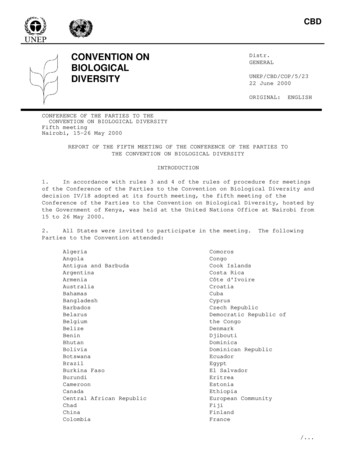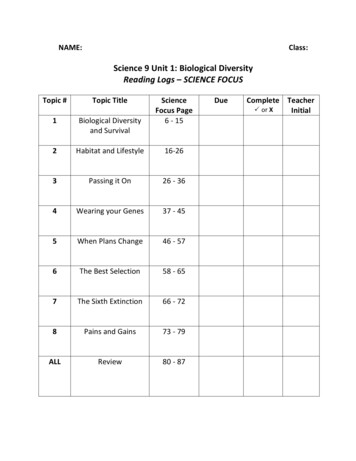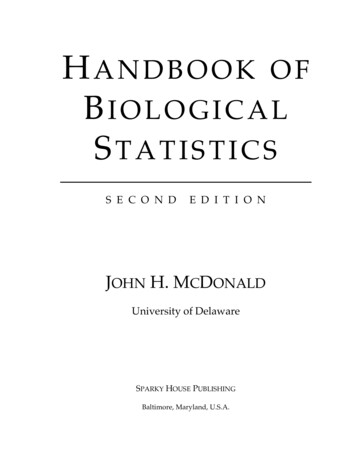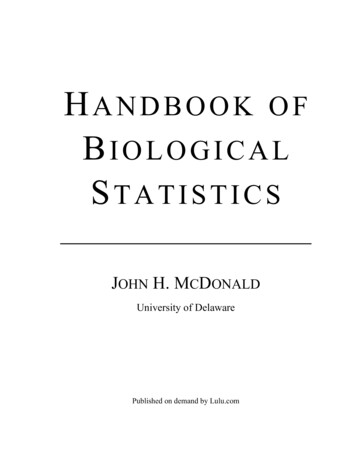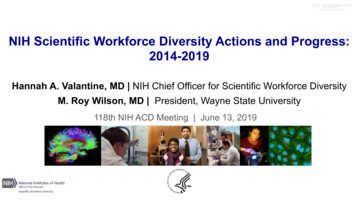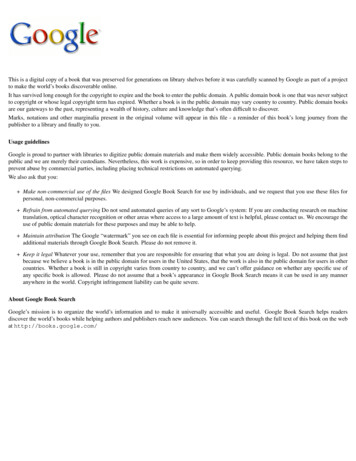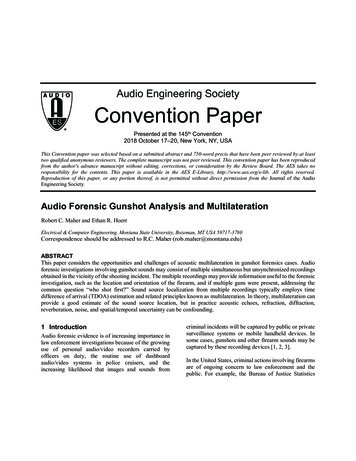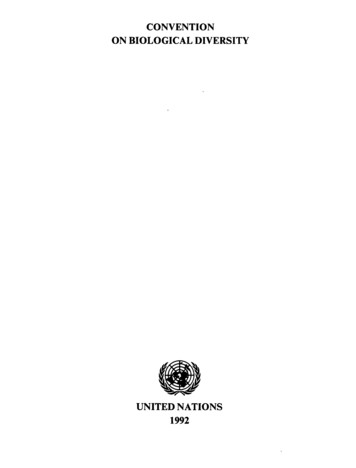
Transcription
CONVENTIONON BIOLOGICAL DIVERSITYUNITED NATIONS1992
CONVENTION ON BIOLOGICAL DIVERSITYPreamble The Contracting Parties,Conscious of the intrinsic value of biological diversity and of theecological, genetic, social, economic, scientific, educational, cultural,recreational and aesthetic values of biological diversity and itscomponents.Conscious also of the importance of biological diversity forevolution and for maintaining life sustaining systems of the biosphere,Affirming that the conservation of biological diversity is a commonconcern of humankind,Reaffirming that Statesbiological resources.havesovereignrights overtheir ownReaffirming also that States are responsible for conserving theirbiological diversity and for using their biological resources in asustainable manner,Concerned that biological diversity is being significantly reducedby certain human activities.Aware of the gênerai lack of information and knowledge regardingbiological diversity and of the urgent need to develop scientific,technical and institutional capacities to provide the basic understandingupon which to plan and implement appropriate measures,Noting that it is vital to anticipate, prevent and attack the causesof significant reduction or loss of biological diversity at source,Noting also that where there is a threat of significant reduction orloss of biological diversity, lack of full scientific certainty shouldnot be used as a reason for postponing measures to avoid or minimize sucha threat.Noting further that the fundamentalrequirement for theconservation of biological diversity is the in-situ conservation ofecosystems and natural habitats and the maintenance and recovery ofviable populations of species in their natural surroundings,Noting further that ex-si tu measures, preferablyorigin, also have an important role to play,in the country ofRecognizing the close and traditional dependence of many indigenousand local communities embodying traditional lifestyles on biologicalresources, and the desirability of sharing equitably benefits arising
from the use of traditional knowledge, innovations and practices relevantto the conservation of biological diversity and the sustainable use ofits components,Recognizing ai so the vital role that women play in the conservationand sustainable use of biological diversity and affirming the neea forthe full participation of women at all levels of policy-making andimplementation for biological diversity conservation,Stressing the importance of, and the need to promote, international,regional and global cooperation among States andintergovernmentalorganizations and the non-governmental sector for the conservation ofbiological diversity and the sustainable use of its components,Acknowledging that the provision of new and additional financialresources and appropriate access to relevant technologies can be expectedto make a substantial difference in the world's ability to address theloss of biological diversity,Acknowledging further that special provision is required to meetthe needs of developing countries, including the provision of new andadditional financial resources and appropriate access to relevanttechnologies,Noting in this regard the special conditions of the least developedcountries and small island States,Acknowledging that substantial investments are required to conservebiological diversity and that there is the expectation of a broad rangeof environmental, economic and social benefits from those investments,Recognizing that economic and social development and povertyeradication are the first and overriding priorities of developingcountries,Aware that conservation and sustainable use of biological diversityis of critical importance for meeting the food, health and other needs ofthe growing world population, for which purpose access to and sharing ofboth genetic resources and technologies are essential,Noting that, ultimately, the conservation and sustainable use ofbiological diversity will strengthen friendly relations among States andcontribute to peace for humankind,Desiring to enhance and complement existing internationalarrangements for the conservation of biological diversity and sustainableuse of its components, andDetermined to conserve and sustainably usethe benefit of present and future generations.biological diversity for
Have agreed as follows:Article I. ObjectivesThe objectives of this Convention, to be pursued in accordance withits relevant provisions, are the conservation of biological diversity.the sustainable use of its components and the fair and equitable sharingof the benefits arising out of the utilization of genetic resources,including by appropriate access to genetic resources and by appropriatetransfer of relevant technologies, taking into account all rights overthose resources and to technologies, and by appropriate funding.AT tic I e 2. Use of TermsFor the purposes of this Convention:"Biological diversity" means the variability among living organisms fromall sources including, inter alia, terrestrial, marine and other aquaticecosystems and the ecological complexes of which they are part: thisincludes diversity within species, between species and of ecosystems."Biological resources' includes genetic resources, organisms or partsthereof, populations, or any other biotic component of ecosystems withactual or potential use or value for humanity."Biotechnology" means any technological application that uses biologicalsystems, living organisms, or derivatives thereof, to make or modifyproducts or processes for specific use."Country of origin of genetic resources" means the countrypossesses those genetic resources in in-situ conditions.which"Country providing genetic resources' means the country supplying geneticresources collected from in situ sources, including populations of bothwild and domesticated species, or taken from ex-si tu sources, which mayor may not have originated in that country."Domesticated or cultivated species' means speciesin which theevolutionary process has been influenced by humans to meet their needs."Ecosystem" means a dynamic complex of plant, animal and micro-organismcommunities and their non-living environment interacting as a functionalunit."Ex-situ conservation" means the conservation of components of biologicaldiversity outside their natural habitats."Genetic material" means any material of plant, animal, microbial orother origin containing functional units of heredity."Genetic resources" means genetic material of actual or potential value.
'Habitat" means the place or type of site where an organism or populationnaturally occurs.In-situ conditions' means «-onditions where genetic resources existwithin ecosystems and natural habitats, and. in the case of domesticatedor cultivated species, in the surroundings where they have developedtheir distinctive properties."In-situ conservation' means the conservation of ecosystems and naturalhabitats and the maintenance and recovery of viable populations ofspecies in their natural surroundings and, in the case of domesticated orcultivated species, in the surroundings where they have developed theirdistinctive properties."Protected area" means a geographically defined area which is designatedor regulated and managed to achieve specific conservation objectives.Regional economic integration organization"means an organizationconstituted by sovereign States of a given region, to which its memberStates have transferred competence in respect of matters governed by thisConvention and which has been duly authorized, in accordance with itsinternal procedures, to sign, ratify, accept, approve or accede to it."Sustainable use" means the use of components of biological diversity ina way and at a rate that does not lead to the long-term decline ofbiological diversity, thereby maintaining its potential to meet the needsand aspirations of present and future generations."Technology" includes biotechnology.Article 3. PrincipleStates have, in accordance with the Charter of the United Nationsand the principles of international law, the sovereign right to exploittheir own resources pursuant to their own environmental policies, and theresponsibility to ensure that activities within their jurisdiction orcontrol do not cause damage to the environment of other States or ofareas beyond the limits of national jurisdiction.Article 4. Jurisdictional ScopeSubject to the rights of other States, and except as otherwiseexpressly provided in this Convention, the provisions of this Conventionapply, in relation to each Contracting Party:(a) In the case of components of biological diversity, in areaswithin the limits of its national jurisdiction; and
(b) In the case of processes and activities, regardless of wheretheir effects occur, carried out under its jurisdiction or control,within the area of its national jurisdiction or beyond the limits ofnational jurisdiction.Article 5. CooperationEach Contracting Party shall, as far as possible and as appropriate,cooperate with other Contracting Parties, directly or. where appropriate,through competent international organizations, in respect of areas beyondnational jurisdiction and on other matters of mutual interest, for theconservation and sustainable use of biological diversity.Article 6. General Measures for Conservation and Sustainable UseEach Contracting Partyconditions and capabilities:shall, in accordance with its particular(a) Develop national strategies, plans or programmes for theconservation and sustainable use of biological diversity or adapt forthis purpose existing strategies, plans or programmes which shallreflect, inter alia, the measures set out in this Convention relevant tothe Contracting Party concerned; and(b) Integrate, as far as possible and as appropriate, theconservation and sustainable use of biological diversity into relevantsectoral or cross-sectoral plans, programmes and policies.Article 7. Identification and MonitoringEach Contracting Party shall, as far as possible and as appropriate,in particular for the purposes of Articles 8 to 10:(a) Identify components of biological diversity important for itsconservation and sustainable use having regard to the indicative list ofcategories set down in Annex I:(b) Monitor, through sampling and other techniques, the componentsof biological diversity identified pursuant to subparagraph (a) above,paying particular attention to those requiring urgent conservationmeasures and those which offer the greatest potential for sustainableuse;(c) Identify processes and categories of activities which have orare likely to have significant adverse impacts on the conservation andsustainable use of biological diversity, and monitor their effectsthrough sampling and other techniques; and(d) Maintain and organize, by any mechanism data, derived fromidentification and monitoring activities pursuant to subparagraphs (a),(b) and (c) above.
Article 8. In-situ ConservationEach Contracting Party shall, as far as possible and as appropriate:(a) Establish a system of protected areas or areas where specialmeasures need to be taken to conserve biological diversity:(b) Develop, where necessary, guidelines for the selection,establishment and management of protected areas or areas where specialmeasures need to be taken to conserve biological diversity:(c) Regulate or manage biological resources important for theconservation of biological diversity whether within or outside protectedareas, with a view to ensuring their conservation and sustainable use;(d) Promote the protection of ecosystems, natural habitats and themaintenance of viable populations of species in natural surroundings:(e) Promote environmentally sound and sustainable development inareas adjacent to protected areas with a view to furthering protection ofthese areas:(f) Rehabilitate and restore degraded ecosystems and promote therecovery of threatened species, inter alia, through the development andimplementation of plans or other management strategies:(g) Establish or maintain means to regulate, manage or control therisks associated with the use and release of living modified organismsresulting from biotechnologywhich are likely to have adverseenvironmental impacts that could affect the conservation and sustainableuse of biological diversity, taking also into account the risks to humanhealth:(h) Prevent the introduction of, control or eradicate those alienspecies which threaten ecosystems, habitats or species:(i) Endeavour to provide the conditions needed for compatibilitybetween present uses and the conservation of biological diversity and thesustainable use of its components:(j) Subject to its national legislation, respect, preserve andmaintain knowledge, innovations and practices of indigenous and localcommunities embodyingtraditionallifestyles relevant for theconservation and sustainable use of biological diversity and promotetheir wider application with the approval and involvement of the holdersof such knowledge, innovations and practices and encourage the equitablesharing of the benefits arising from the utilization of such knowledge,innovations and practices:
(k) Develop or maintain necessary legislation and/or otherregulatory provisions for the protection of threatened species andpopulations:(1) Where a significant adverse effect on biological diversity hasbeen determined pursuant to Article 7, regulate or manage the relevantprocesses and categories of activities: and(m) Cooperate in providing financial and other support for in-situconservation outlined in subparagraphs (a) to (1) above, particularly todeveloping countries.Article 9. Ex-si tu ConservationEach Contracting Party shall, as far as possible and as appropriate,and predominantly for the purpose of complementing in-situ measures:(a) Adopt measures for the ex-si tu conservation of components ofbiological diversity, preferably in tne country of origin of suchcomponents :(b) Establish and maintain facilities for ex-situ conservation ofand research on plants, animals and micro-organisms, preferably in thecountry of origin of genetic resources:(c) Adopt measures for the recovery and rehabilitation ofthreatened species and for their reintroduction into their naturalhabitats under appropriate conditions;(d) Regulate and manage collection of biologicalnatural habitats for ex-situ conservation purposes so asecosystems and in-situ populations of species, excepttemporary ex-si tu measures are required under subparagraphresources fromnot to threatenwhere special(c) above: and(e) Cooperate in providing financial and other support for ex-situconservation outlined in subparagraphs (a) to (d) above and in theestablishment and maintenance of ex-situ conservation facilities indeveloping countries.Article 10. Sustainable Use of Components of Biological DiversityEach Contracting Party shall, as far as possible and as appropriate:(a) Integrate consideration of the conservation and sustainable useof biological resources into national decision-making;(b) Adopt measures relating to the use of biological resources toavoid or minimize adverse impacts on biological diversity;
(c) Protect ала encourage customary use of biological resources inaccordance with traditional cultural practices that are compatible withconservation or sustainable use requirements;(d) Support local populations to develop and implement remedialaction in degraded areas where biological diversity has been reduced;and(e) Encourage cooperation between its governmental authorities andits private sector in developing methodsfor sustainable use ofbiological resources.Article 11.Incen t i ve MeasuresEach Contracting Party shall, as far as possible and as appropriate,adopt economically and socially sound measures that act as incentives forthe conservation and sustainable use of components of biologicaldiversity.Article 12. Research and TrainingThe Contracting Parties, takingdeveloping countries, shall:into account the specialneeds of(a) Establish and maintain programmes for scientific and technicaleducation and training in measures for the identification, conservationand sustainable use of biological diversity and its components andprovide support for such education and training for the specific needs ofdeveloping countries:(b) Promoteand encourage research which contributes to theconservation and sustainable use of biological diversity, particularly indeveloping countries, inter alia, in accordance with decisions of theConference of the Parties taken in consequence of recommendations of theSubsidiary Body on Scientific, Technical and Technological Advice: and(c) In keeping with the provisions of Articles 16. 13 and 20.promote and cooperate in the use of scientific advances in biologicaldiversity research in developing methods for conservation and sustainableuse of biological resources.Article 13. Public Education and AwarenessThe Contracting Parties shall:(a) Promote and encourage understanding of the importance of. andthe measures required for, the conservation of biological diversity, aswell as its propagation through media, and the inclusion of these topicsin educational programmes; and
(b) Cooperate, as appropriate, with other States and internationalorganizations in developing educational and public awareness programmes,with respect to conservation and sustainable use of biological diversity.Article 14. Impact Assessment and Minimizing Adverse Impacts1. Each Contracting Party, as far as possible and as appropriate,shai1 :(a) Introduce appropriate procedures requiring environmental impactassessment of its proposed projects that are likeiy to have significantadverse effects on biological diversity with a view to avoiding orminimizing such effects and, where appropriate. allow for publicparticipation in such procedures;(b) Introduce appropriate arrangementsto ensure that theenvironmental consequences of its programmes and policies that are likelyto have significant adverse impacts on biological diversity are dulytaken into account:(c) Promote, on the basis of reciprocity, notification, exchange nfinformation and consultation on activities under their jurisdiction orcontrol which are likely to significantly affect adversely the biologicaldiversity of other States or areas beyond the limits of nationaljurisdiction, by encouraging the conclusion of bilateral, regional ormultilateral arrangements, as appropriate;(d) In the case of imminent or grave danger or damage, originatingunder its jurisdiction or control, to biological diversity within thearea under jurisdiction of other States or in areas beyond the limits ofnational jurisdiction, notify immediately the potentially affected Statesof such danger or damage, as well as initiate action to prevent orminimize such danger or damage; and(e) Promote national arrangements for emergency responses toactivities or events, whether caused naturally or otherwise, whichpresent a grave and imminent danger to biological diversity and encourageinternational cooperation to supplement such national efforts and, whereappropriate and agreed by the States or regional economic Integrationorganizations concerned, to establish joint contingency plans.2. The Conference of the Parties shall examine, on the basis of studiesto be carried out, the issue of liability and redress, includingrestoration and compensation, for damage to biological diversity, exceptwhere such liability is a purely internal matter.Article 15. Access to Genetic Resources1.Recognizing the sovereign rights of States over their naturalresources, the authority to determine access to genetic resources restswith the national governments and is subject to national legislation.
2. Each Contracting Party shall endeavour to create renditions tofacilitate access to genetic resources for environmentally sound uses byother Contracting Parties and not to impose restrictions that run counterto the objectives of this Convention.3. For the purpose of this Convention, the genetic resources beingprovided by a Contracting Party, as referred to in this Article andArticles 16 and 19, are only those that are provided by ContractingParties that are countries of origin of such resources or by the Partiesthat have acquired the genetic resources in accordance with thisConvention.4. Access, where granted, shall be on mutually agreed terms and subjectto the provisions of this Article.5. Access to genetic resources shall be subject to prior informedconsent of the ContractingParty providing such resources, unlessotherwise determined by that Party.6. Each Contracting Party shall endeavour to develop and carry outscientific research based on genetic resources provided by otherContracting Parties with the full participation of, and where possiblein. such Contracting Parties.7. Each Contracting Party shall take legislative, administrative orpolicy measures, as appropriate, and in accordance with Articles 16 and19 and, where necessary, through the financial mechanism established byArticles 20 and 21 with the aim of sharing in a fair and equitable waythe results of research and development and the benefits arising from thecommercial and other utilization of genetic resources with theContracting Party providing such resources. Such sharing shall be uponmutually agreed terms.Article 16. Access to and Transfer of Technology1.Each Contracting Party, recognizingthat technology includesbiotechnology, and that both access to and transfer of technology amongContracting Parties are essential elements for the attainment of theobjectives of this Convention, undertakes subject to the provisions ofthis Article to provide and/or facilitate access for and transfer toother Contracting Parties of technologies that are relevant to theconservation and sustainable use of biological diversity or make use ofgenetic resources and do not cause significant damage to the environment.2. Access to and transfer of technology referred to in paragraph 1above to developing countries shall be provided and/or facilitated underfair and most favourable terms, including on concessional andpreferential terms where mutually agreed, and, where necessary, inaccordance with the financial mechanism established by Articles 20 and21. In the case of technology subject to patents and other intellectualproperty rights, such access and transfer shall be provided on terms10
which recognize and are consistent with the adequate and effectiveprotection of intellectual property rights. The application of thisparagraph shall be consistent with paragraphs 3, 4 and 5 below.3. Each Contracting Party shall take legislative, administrative orpolicy measures, as appropriate, with the aim that Contracting Parties,in particular those that are developing countries, which provide geneticresources are provided access to and transfer of technology which makesuse of those resources, on mutually agreed terms, including technologyprotected by patents and other intellectual property rights, wherenecessary, through the provisions of Articles 20 and 21 and in accordancewith international law and consistent with paragraphs 4 and 5 below.4. Each Contracting Party shall take legislative, administrative orpolicy measures, as appropriate, with the aim that the private sectorfacilitates access to, joint development and transfer of technologyreferred to in paragraph 1 above for the benefit of both governmentalinstitutions and the private sector of developing countries and in thisregard shall abide by the obligations included in paragraphs 1. 2 and 3above.5. The Contracting Parties, recognizingthat patents and otherintellectual property rights may have an influence on the implementationof this Convention, shall cooperate in this regard subject to nationallegislation and international law in order to ensure that such rights aresupportive of and do not run counter to its objectives.Article 17.Exchange of Information1. The Contracting Parties shall facilitate the exchange ofinformation, from all publicly available sources, relevant to theconservation and sustainable use of biological diversity, taking intoaccount the special needs of developing countries.2. Such exchange of information shall include exchange of results oftechnical, scientific and socio-economic research, as well as informationon training and surveying programmes, specialized knowledge, indigenousand traditional knowledge as such and in combination with thetechnologies referred to in Article 16, paragraph 1. It shall also,where feasible, include repatriation of information.Article 18. Technical and Scientific Cooperation1. The Contracting Parties shall promote international technical andscientific cooperation in the field of conservation and sustainable useof biological diversity, where necessary,through the appropriateinternational and national institutions.11
2. Each ContractingParty shall promote technical and scientificcooperation with other Contracting Parties, in particular developingcountries, in implementing this Convention, inter alia, through thedevelopment and implementation of national policies. In promoting suchcooperation, special attention should be given to the development andstrengthening of national capabilities, by means of human resourcesdevelopment and institution building.3. The Conference of the Parties, at its first meeting, shall determinehow to establish a clearing-house mechanism to promote and facilitatetechnical and scientific cooperation.4. The Contracting Parties shall,in accordance with nationallegislation and policies, encourage and develop methods of cooperationfor the development and use of technologies, including indigenous andtraditional technologies, in pursuance of the objectives of thisConvention. For this purpose, the Contracting Parties shall also promotecooperation in the training of personnel and exchange of experts.5. The Contracting Parties shall, subject to mutual agreement, promotethe establishment of joint researcn programmes and joint ventures for thedevelopment of technologies relevant to the objectives of thisConvention.Article 19. Handling of Biotechnology' and Distribution of its Benefits1. Each Contracting Party shall take legislative, administrative orpolicy measures, as appropriate.to provide forthe Affectiveparticipation in biotechnological research activities Dy thoseContracting Parties, especially developing countries, which provide thegenetic resources for such research, and where feasible in suchContracting Parties.2. Each Contracting Party shall take all practicable measures topromote and advance priority access on a fair and equitable basis byContracting Parties, especially developing countries, to т!ле results andbenefits arising from biotechnologies based upon genetic resourcesprovided by those Contracting Parties. Such access shall be on mutuallyagreed terms.3. The Parties shall consider the need for and modalities of a protocolsetting out appropriate procedures, including, in particular, advanceinformed agreement, in the field of the safe transfer, handling and useof any living modified organism resulting from biotechnology that mayhave adverse effect on the conservation and sustainable use of biologicaldiversity.4. Each Contracting Party shall, directly or by requiring any naturalor legal person under its jurisdiction providing the organisms referredto in paragraph 3 above, provide any available information about the useand safety regulations required by that Contracting Party in handling12
such organisms, as well as any available information on the potentialadverse impact of the specific organisms concerned to the ContractingParty into which those organisms are to be introduced.Article 20. Financial Resources1.Each Contracting Party undertakes to provide,capabilities, financial support and incentivesnational activities which are intended to achieveConvention, in accordance withits nationalprogrammes.in accordance with itsin respect of thosethe objectives of thisplans, priorities and2. The developed country Parties shall provide new and additionalfinancial resources to enable developing country Parties to meet theagreed full incremental costs to them of implementing measures whichfulfil the obligations of this Convention and to benefit from itsprovisions and which costs are agreed between a developing country Partyand the institutional structure referred to in Article 21, in accordancewith policy, strategy, programme priorities and eligibility criteria andan indicative list of incremental costs established by the Conference nfthe Parties. Other Parties, including countries undergoing the processof transition to a market economy, may voluntarily assume the obligationsof the developed country Parties. For the purpose of this Article, theConference of the Parties, shall at its first meeting establish a list ofdeveloped country Parties and other Parties which voluntarily assume iheobligations of the developed country Parties. The Conference of theParties shall periodically review and if necessary amend the list.Contributions from other countries and sources on a voluntary basis wouldalso be encouraged. The implementation of these commitments shall takeinto account the need for adequacy, predictability and timely flow offunds and the importance of burden-sharing among the contributing Partiesincluded in the list.3. The developed country Parties may also provide, and developingcountry Parties avail themselves of, financial resources related to theimplementation of this Convention through bilateral, regional and othermultilateral channels.4. The extent to which developing country Parties will effectivelyimplement their commitments under this Convention w i l l depend on theeffective implementat ion by developedcountry Parties oftheircommitments under this Convention related to financial resources andtransfer of technology and will take fully into account the fact thateconomic and social development and eradication of poverty are the
States have transferred competence in respect of matters governed by this Convention and which has been duly authorized, in accordance with its internal procedures, to sign, ratify, accept, approve or accede to it. "Sustainable use" means the use of components of biological diversity in a way and at a rate that does not lead to the long-term .
